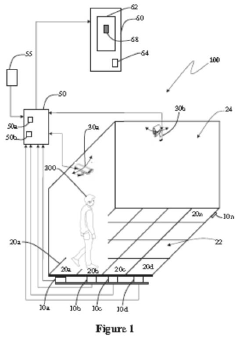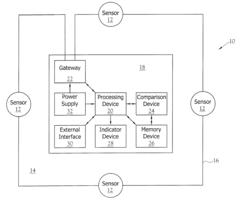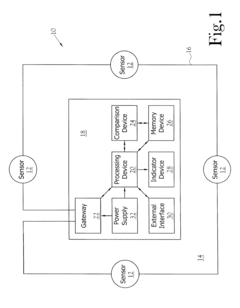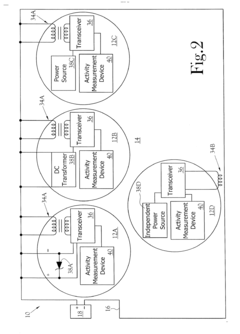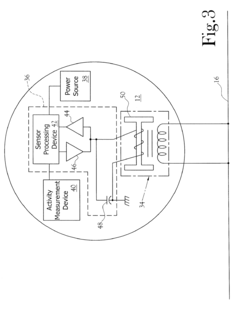Security Systems Enhanced by Piezoelectric Sensors
JUL 17, 20259 MIN READ
Generate Your Research Report Instantly with AI Agent
Patsnap Eureka helps you evaluate technical feasibility & market potential.
Piezoelectric Sensor Security Evolution
The evolution of piezoelectric sensor security systems has been marked by significant technological advancements and a growing recognition of their potential in enhancing safety and surveillance capabilities. Initially developed for industrial applications, piezoelectric sensors have gradually found their way into security systems, offering unique advantages in detecting and monitoring various physical phenomena.
In the early stages, piezoelectric sensors were primarily used for basic intrusion detection, leveraging their ability to generate an electrical charge in response to mechanical stress or vibration. This allowed for the creation of simple alarm systems that could detect forced entry attempts through doors or windows. As the technology matured, the sensitivity and reliability of these sensors improved, enabling more sophisticated applications in perimeter security.
The mid-2000s saw a significant leap in piezoelectric sensor integration within comprehensive security systems. Manufacturers began incorporating these sensors into multi-layered security solutions, combining them with other technologies such as infrared sensors and video surveillance. This integration allowed for more accurate threat detection and reduced false alarms, a critical improvement in the field of security.
Advancements in signal processing and data analysis techniques further enhanced the capabilities of piezoelectric sensor-based security systems. Machine learning algorithms were developed to interpret the complex data generated by these sensors, enabling the differentiation between benign environmental disturbances and genuine security threats. This led to the creation of intelligent security systems capable of adapting to various environments and conditions.
Recent years have witnessed the emergence of networked piezoelectric sensor arrays in security applications. These systems utilize multiple sensors distributed across a protected area, working in concert to provide comprehensive coverage and precise localization of potential threats. The advent of Internet of Things (IoT) technologies has further expanded the possibilities, allowing for real-time monitoring and remote management of security systems enhanced by piezoelectric sensors.
The miniaturization of piezoelectric sensors has opened up new avenues for their application in personal and mobile security devices. Wearable technology and smartphones now incorporate these sensors to detect falls, impacts, or sudden movements, providing an additional layer of security for individuals in various settings.
Looking ahead, the integration of artificial intelligence and advanced analytics promises to further revolutionize piezoelectric sensor-based security systems. Predictive algorithms may soon enable these systems to anticipate potential security breaches before they occur, marking a shift from reactive to proactive security measures.
In the early stages, piezoelectric sensors were primarily used for basic intrusion detection, leveraging their ability to generate an electrical charge in response to mechanical stress or vibration. This allowed for the creation of simple alarm systems that could detect forced entry attempts through doors or windows. As the technology matured, the sensitivity and reliability of these sensors improved, enabling more sophisticated applications in perimeter security.
The mid-2000s saw a significant leap in piezoelectric sensor integration within comprehensive security systems. Manufacturers began incorporating these sensors into multi-layered security solutions, combining them with other technologies such as infrared sensors and video surveillance. This integration allowed for more accurate threat detection and reduced false alarms, a critical improvement in the field of security.
Advancements in signal processing and data analysis techniques further enhanced the capabilities of piezoelectric sensor-based security systems. Machine learning algorithms were developed to interpret the complex data generated by these sensors, enabling the differentiation between benign environmental disturbances and genuine security threats. This led to the creation of intelligent security systems capable of adapting to various environments and conditions.
Recent years have witnessed the emergence of networked piezoelectric sensor arrays in security applications. These systems utilize multiple sensors distributed across a protected area, working in concert to provide comprehensive coverage and precise localization of potential threats. The advent of Internet of Things (IoT) technologies has further expanded the possibilities, allowing for real-time monitoring and remote management of security systems enhanced by piezoelectric sensors.
The miniaturization of piezoelectric sensors has opened up new avenues for their application in personal and mobile security devices. Wearable technology and smartphones now incorporate these sensors to detect falls, impacts, or sudden movements, providing an additional layer of security for individuals in various settings.
Looking ahead, the integration of artificial intelligence and advanced analytics promises to further revolutionize piezoelectric sensor-based security systems. Predictive algorithms may soon enable these systems to anticipate potential security breaches before they occur, marking a shift from reactive to proactive security measures.
Market Demand Analysis
The market demand for security systems enhanced by piezoelectric sensors has been experiencing significant growth in recent years. This surge is primarily driven by the increasing need for advanced security solutions across various sectors, including residential, commercial, and industrial applications. Piezoelectric sensors offer unique advantages in security systems, such as high sensitivity, reliability, and the ability to detect minute vibrations or pressure changes, making them ideal for intrusion detection and perimeter security.
In the residential sector, there is a growing demand for smart home security systems that can provide real-time alerts and seamless integration with other smart devices. Piezoelectric sensors play a crucial role in this ecosystem by offering enhanced sensitivity and accuracy in detecting unauthorized entry attempts. The rise in property crimes and the increasing awareness of home security among consumers are key factors driving this demand.
The commercial sector, including retail stores, office buildings, and warehouses, is another significant market for piezoelectric sensor-enhanced security systems. These businesses require robust security measures to protect their assets, employees, and customers. Piezoelectric sensors offer an effective solution for monitoring access points, detecting glass breakage, and identifying potential security breaches. The need for non-intrusive yet highly effective security measures in commercial spaces is fueling the adoption of these advanced sensor technologies.
Industrial applications represent a substantial market opportunity for piezoelectric sensor-based security systems. Manufacturing facilities, power plants, and critical infrastructure sites require sophisticated security solutions to safeguard against theft, sabotage, and unauthorized access. Piezoelectric sensors can be integrated into perimeter fencing, doors, and windows to provide comprehensive security coverage. The increasing focus on industrial safety and compliance with stringent security regulations is driving the demand in this sector.
The global market for security systems enhanced by piezoelectric sensors is expected to grow steadily over the next few years. Factors contributing to this growth include technological advancements in sensor design, increasing integration with artificial intelligence and machine learning algorithms, and the overall trend towards smart and connected security solutions. Additionally, the rising concerns over terrorism and the need for enhanced border security are creating new opportunities for piezoelectric sensor applications in government and defense sectors.
However, the market also faces certain challenges. The relatively higher cost of piezoelectric sensors compared to traditional security sensors may limit adoption in price-sensitive segments. Additionally, concerns over privacy and data security associated with advanced sensing technologies could potentially impact market growth. Despite these challenges, the overall market outlook remains positive, with innovations in sensor miniaturization and improved energy efficiency expected to drive further adoption across various industries.
In the residential sector, there is a growing demand for smart home security systems that can provide real-time alerts and seamless integration with other smart devices. Piezoelectric sensors play a crucial role in this ecosystem by offering enhanced sensitivity and accuracy in detecting unauthorized entry attempts. The rise in property crimes and the increasing awareness of home security among consumers are key factors driving this demand.
The commercial sector, including retail stores, office buildings, and warehouses, is another significant market for piezoelectric sensor-enhanced security systems. These businesses require robust security measures to protect their assets, employees, and customers. Piezoelectric sensors offer an effective solution for monitoring access points, detecting glass breakage, and identifying potential security breaches. The need for non-intrusive yet highly effective security measures in commercial spaces is fueling the adoption of these advanced sensor technologies.
Industrial applications represent a substantial market opportunity for piezoelectric sensor-based security systems. Manufacturing facilities, power plants, and critical infrastructure sites require sophisticated security solutions to safeguard against theft, sabotage, and unauthorized access. Piezoelectric sensors can be integrated into perimeter fencing, doors, and windows to provide comprehensive security coverage. The increasing focus on industrial safety and compliance with stringent security regulations is driving the demand in this sector.
The global market for security systems enhanced by piezoelectric sensors is expected to grow steadily over the next few years. Factors contributing to this growth include technological advancements in sensor design, increasing integration with artificial intelligence and machine learning algorithms, and the overall trend towards smart and connected security solutions. Additionally, the rising concerns over terrorism and the need for enhanced border security are creating new opportunities for piezoelectric sensor applications in government and defense sectors.
However, the market also faces certain challenges. The relatively higher cost of piezoelectric sensors compared to traditional security sensors may limit adoption in price-sensitive segments. Additionally, concerns over privacy and data security associated with advanced sensing technologies could potentially impact market growth. Despite these challenges, the overall market outlook remains positive, with innovations in sensor miniaturization and improved energy efficiency expected to drive further adoption across various industries.
Current Challenges
The integration of piezoelectric sensors into security systems presents several significant challenges that need to be addressed for widespread adoption and optimal performance. One of the primary obstacles is the sensitivity and accuracy of these sensors in real-world environments. While piezoelectric sensors excel at detecting vibrations and pressure changes, they can be prone to false alarms triggered by environmental factors such as wind, heavy traffic, or construction work nearby. This oversensitivity can lead to a high rate of false positives, potentially undermining the reliability of the security system.
Another challenge lies in the power requirements of piezoelectric sensor networks. Although individual sensors are relatively low-power devices, large-scale deployments in comprehensive security systems can result in significant energy consumption. This issue is particularly pronounced in remote or hard-to-reach areas where regular battery replacement or wired power supply may not be feasible. Developing energy-efficient solutions or incorporating energy harvesting technologies to power these sensors remains a critical area of focus.
Data processing and interpretation present another set of challenges. The vast amount of data generated by piezoelectric sensor arrays requires sophisticated algorithms and processing capabilities to accurately distinguish between genuine security threats and benign environmental stimuli. This necessitates the development of advanced machine learning and artificial intelligence systems capable of real-time data analysis and decision-making, which can be computationally intensive and expensive to implement.
Durability and longevity of piezoelectric sensors in diverse environmental conditions pose additional challenges. Exposure to extreme temperatures, humidity, and physical stress can affect the performance and lifespan of these sensors. Ensuring consistent operation and maintaining calibration over extended periods, especially in harsh outdoor environments, requires ongoing research into materials science and protective enclosures.
Integration with existing security infrastructure is another hurdle that needs to be overcome. Many organizations have already invested heavily in traditional security systems, and the seamless incorporation of piezoelectric sensor technology into these existing frameworks can be complex and costly. Developing standardized interfaces and protocols for interoperability between piezoelectric sensors and various security platforms is crucial for widespread adoption.
Lastly, the cost-effectiveness of implementing piezoelectric sensor-enhanced security systems on a large scale remains a significant challenge. While the technology shows promise, the initial investment required for sensor deployment, data processing infrastructure, and system integration can be substantial. Demonstrating a clear return on investment and tangible security benefits is essential to encourage adoption by businesses and institutions.
Another challenge lies in the power requirements of piezoelectric sensor networks. Although individual sensors are relatively low-power devices, large-scale deployments in comprehensive security systems can result in significant energy consumption. This issue is particularly pronounced in remote or hard-to-reach areas where regular battery replacement or wired power supply may not be feasible. Developing energy-efficient solutions or incorporating energy harvesting technologies to power these sensors remains a critical area of focus.
Data processing and interpretation present another set of challenges. The vast amount of data generated by piezoelectric sensor arrays requires sophisticated algorithms and processing capabilities to accurately distinguish between genuine security threats and benign environmental stimuli. This necessitates the development of advanced machine learning and artificial intelligence systems capable of real-time data analysis and decision-making, which can be computationally intensive and expensive to implement.
Durability and longevity of piezoelectric sensors in diverse environmental conditions pose additional challenges. Exposure to extreme temperatures, humidity, and physical stress can affect the performance and lifespan of these sensors. Ensuring consistent operation and maintaining calibration over extended periods, especially in harsh outdoor environments, requires ongoing research into materials science and protective enclosures.
Integration with existing security infrastructure is another hurdle that needs to be overcome. Many organizations have already invested heavily in traditional security systems, and the seamless incorporation of piezoelectric sensor technology into these existing frameworks can be complex and costly. Developing standardized interfaces and protocols for interoperability between piezoelectric sensors and various security platforms is crucial for widespread adoption.
Lastly, the cost-effectiveness of implementing piezoelectric sensor-enhanced security systems on a large scale remains a significant challenge. While the technology shows promise, the initial investment required for sensor deployment, data processing infrastructure, and system integration can be substantial. Demonstrating a clear return on investment and tangible security benefits is essential to encourage adoption by businesses and institutions.
Existing Security Solutions
01 Piezoelectric sensor design and structure
This category focuses on the design and structure of piezoelectric sensors. It includes innovations in sensor geometry, material selection, and layering techniques to optimize sensitivity and performance. These designs aim to enhance the sensor's ability to convert mechanical stress into electrical signals efficiently.- Piezoelectric sensor design and structure: Piezoelectric sensors are designed with specific structures to optimize their sensing capabilities. These designs may include layered configurations, specialized electrode arrangements, or unique geometries to enhance sensitivity and performance. The structure of the sensor plays a crucial role in determining its response to mechanical stress and its ability to generate electrical signals.
- Applications in automotive and transportation: Piezoelectric sensors find extensive use in automotive and transportation sectors. They are employed for various purposes such as tire pressure monitoring, engine knock detection, and vehicle weight measurement. These sensors provide critical data for improving vehicle performance, safety, and efficiency in modern transportation systems.
- Integration with electronic devices and user interfaces: Piezoelectric sensors are increasingly integrated into electronic devices and user interfaces. They are used in touchscreens, haptic feedback systems, and gesture recognition technologies. This integration allows for more intuitive and responsive user interactions in smartphones, tablets, and other consumer electronics.
- Industrial and manufacturing applications: In industrial settings, piezoelectric sensors play a vital role in process monitoring and quality control. They are used for measuring pressure, force, and vibration in manufacturing processes. These sensors enable precise measurements and real-time monitoring, contributing to improved product quality and production efficiency.
- Advancements in piezoelectric materials and fabrication: Ongoing research focuses on developing new piezoelectric materials and improving fabrication techniques. This includes exploring novel compositions, nanostructured materials, and advanced manufacturing methods like 3D printing. These advancements aim to enhance the sensitivity, durability, and overall performance of piezoelectric sensors across various applications.
02 Applications of piezoelectric sensors
Piezoelectric sensors find applications in various fields. This category covers their use in touch screens, pressure measurement systems, vibration detection, and automotive technologies. The versatility of these sensors allows for their integration into diverse systems for sensing and measurement purposes.Expand Specific Solutions03 Signal processing and data analysis for piezoelectric sensors
This category encompasses methods and systems for processing and analyzing signals from piezoelectric sensors. It includes techniques for noise reduction, signal amplification, and data interpretation to improve the accuracy and reliability of sensor readings.Expand Specific Solutions04 Fabrication techniques for piezoelectric sensors
This point covers various manufacturing methods for piezoelectric sensors. It includes techniques such as thin-film deposition, microfabrication, and integration of piezoelectric materials with other components. These methods aim to improve sensor performance, miniaturization, and cost-effectiveness in production.Expand Specific Solutions05 Energy harvesting using piezoelectric sensors
This category focuses on the use of piezoelectric sensors for energy harvesting applications. It includes designs and systems that convert mechanical vibrations or pressure into usable electrical energy, potentially powering small electronic devices or serving as self-powered sensing systems.Expand Specific Solutions
Key Industry Players
The security systems enhanced by piezoelectric sensors market is in a growth phase, driven by increasing demand for advanced security solutions across various sectors. The market size is expanding rapidly, with projections indicating significant growth in the coming years. Technologically, piezoelectric sensor-based security systems are maturing, with continuous innovations from key players. Companies like Huawei Technologies, IBM, and Robert Bosch are leading in research and development, while specialized firms such as Ionix Advanced Technologies and Aito BV are focusing on niche applications. Established automotive giants like BMW and Mercedes-Benz are integrating these technologies into vehicle security systems, indicating a broadening application scope. The competitive landscape is diverse, with a mix of large conglomerates and specialized sensor manufacturers vying for market share.
Huawei Technologies Co., Ltd.
Technical Solution: Huawei has developed a comprehensive security system enhanced by piezoelectric sensors, focusing on both physical and cyber security applications. Their solution incorporates ultra-sensitive piezoelectric sensors into their smart city and IoT platforms, enabling real-time monitoring of structural integrity in buildings and critical infrastructure[4]. Huawei's system uses advanced signal processing techniques to filter out background noise and detect subtle changes in vibration patterns that may indicate security breaches or structural issues[5]. Additionally, they have integrated these sensors into their 5G network equipment to detect physical tampering attempts, enhancing the security of telecommunications infrastructure[6].
Strengths: Comprehensive integration with smart city and IoT platforms, dual-use for physical security and structural health monitoring. Weaknesses: Reliance on Huawei's ecosystem may limit interoperability, potential security concerns in some markets due to geopolitical issues.
International Business Machines Corp.
Technical Solution: IBM has developed an AI-enhanced security system that leverages piezoelectric sensors for both physical and cyber security applications. Their approach combines distributed piezoelectric sensor networks with edge computing devices and cloud-based AI analytics to create a comprehensive security solution[9]. The system uses machine learning algorithms to analyze vibration patterns detected by the sensors, identifying potential security threats in real-time. IBM's solution also incorporates blockchain technology to ensure the integrity and tamper-resistance of sensor data, addressing concerns about data manipulation in security systems[10]. Additionally, they have developed piezoelectric-based quantum random number generators to enhance encryption in their security protocols[11].
Strengths: Advanced AI and blockchain integration, comprehensive physical and cyber security solution, scalable from small businesses to large enterprises. Weaknesses: High implementation complexity, potential for over-reliance on AI decision-making, may require significant computational resources.
Core Piezoelectric Innovations
A security system for detecting trespassers
PatentPendingIN202121009122A
Innovation
- A security system utilizing piezoelectric sensors embedded in floor tiles to detect pressure, activating rotatable cameras only when critical pressure is applied, and integrating a face recognition module to differentiate between authorized and unauthorized individuals, reducing false alerts and enhancing surveillance efficiency.
Security System Using Piezoelectric Sensors
PatentInactiveUS20070120668A1
Innovation
- A system using a single conductor wire connected to piezoelectric sensors that communicate with a signal processing device to differentiate between various activities along the perimeter, allowing for accurate detection and alerting of security breaches, and optionally integrating with pet containment systems to condition pets to stay within defined boundaries.
Regulatory Compliance
The integration of piezoelectric sensors into security systems necessitates careful consideration of regulatory compliance across various jurisdictions. In the United States, the Federal Communications Commission (FCC) regulates the electromagnetic emissions of electronic devices, including security systems. Manufacturers must ensure that their piezoelectric sensor-enhanced security systems comply with FCC Part 15 regulations, which govern unintentional radiators. This includes obtaining proper certification and labeling products accordingly.
The European Union imposes its own set of regulations through the CE marking process. Security systems incorporating piezoelectric sensors must meet the requirements of the Radio Equipment Directive (RED) 2014/53/EU, which ensures that radio equipment, including wireless security devices, operates safely and without causing harmful interference. Additionally, compliance with the Electromagnetic Compatibility (EMC) Directive 2014/30/EU is crucial to prevent electromagnetic disturbances.
Data protection and privacy regulations also play a significant role in the deployment of advanced security systems. The General Data Protection Regulation (GDPR) in the EU and similar laws in other regions impose strict requirements on the collection, processing, and storage of personal data. Security systems enhanced with piezoelectric sensors must be designed with privacy-by-design principles, incorporating features such as data minimization and user consent mechanisms.
In the context of workplace surveillance, many countries have specific laws governing the use of monitoring technologies. For instance, in the United States, the Electronic Communications Privacy Act (ECPA) sets boundaries on electronic surveillance in the workplace. Employers implementing piezoelectric sensor-based security systems must navigate these regulations carefully to avoid infringing on employee privacy rights.
Building codes and safety standards present another layer of regulatory compliance. The National Fire Protection Association (NFPA) in the United States provides guidelines for the installation and maintenance of security systems, including those with advanced sensing capabilities. Compliance with these standards is often mandatory for obtaining necessary permits and insurance coverage.
As the technology evolves, regulatory frameworks are likely to adapt. Manufacturers and implementers of piezoelectric sensor-enhanced security systems must stay abreast of emerging regulations and proactively engage with regulatory bodies to ensure ongoing compliance. This may involve participating in industry standards development processes and contributing to public consultations on proposed regulations.
The European Union imposes its own set of regulations through the CE marking process. Security systems incorporating piezoelectric sensors must meet the requirements of the Radio Equipment Directive (RED) 2014/53/EU, which ensures that radio equipment, including wireless security devices, operates safely and without causing harmful interference. Additionally, compliance with the Electromagnetic Compatibility (EMC) Directive 2014/30/EU is crucial to prevent electromagnetic disturbances.
Data protection and privacy regulations also play a significant role in the deployment of advanced security systems. The General Data Protection Regulation (GDPR) in the EU and similar laws in other regions impose strict requirements on the collection, processing, and storage of personal data. Security systems enhanced with piezoelectric sensors must be designed with privacy-by-design principles, incorporating features such as data minimization and user consent mechanisms.
In the context of workplace surveillance, many countries have specific laws governing the use of monitoring technologies. For instance, in the United States, the Electronic Communications Privacy Act (ECPA) sets boundaries on electronic surveillance in the workplace. Employers implementing piezoelectric sensor-based security systems must navigate these regulations carefully to avoid infringing on employee privacy rights.
Building codes and safety standards present another layer of regulatory compliance. The National Fire Protection Association (NFPA) in the United States provides guidelines for the installation and maintenance of security systems, including those with advanced sensing capabilities. Compliance with these standards is often mandatory for obtaining necessary permits and insurance coverage.
As the technology evolves, regulatory frameworks are likely to adapt. Manufacturers and implementers of piezoelectric sensor-enhanced security systems must stay abreast of emerging regulations and proactively engage with regulatory bodies to ensure ongoing compliance. This may involve participating in industry standards development processes and contributing to public consultations on proposed regulations.
Environmental Impact Assessment
The integration of piezoelectric sensors into security systems presents both potential benefits and environmental considerations. These sensors, which convert mechanical stress into electrical signals, offer enhanced sensitivity and reliability in detecting intrusions or unauthorized access. However, their widespread deployment necessitates a thorough assessment of their environmental impact.
The production of piezoelectric materials often involves the use of lead-based compounds, raising concerns about toxicity and environmental contamination. While efforts are being made to develop lead-free alternatives, the current reliance on lead-based piezoelectrics requires careful handling and disposal protocols to prevent soil and water pollution. Additionally, the manufacturing process of these sensors may consume significant energy and resources, contributing to carbon emissions and resource depletion.
On the positive side, piezoelectric sensors can contribute to energy efficiency in security systems. Their ability to generate small amounts of electricity from ambient vibrations could potentially reduce the overall power consumption of security installations. This self-powering capability may lead to decreased reliance on batteries or external power sources, thereby reducing electronic waste and the environmental impact associated with battery production and disposal.
The durability and long lifespan of piezoelectric sensors also present environmental advantages. Their robust nature means fewer replacements are needed over time, reducing the overall material consumption and waste generation associated with security system maintenance. Furthermore, the high sensitivity of these sensors may allow for more targeted and efficient security responses, potentially reducing false alarms and unnecessary energy expenditure in large-scale surveillance operations.
However, the increased sensitivity of piezoelectric-enhanced security systems may raise concerns about electromagnetic pollution. The constant monitoring and transmission of data could contribute to the growing issue of electromagnetic smog in urban environments. This necessitates careful consideration of sensor placement and signal management to minimize potential impacts on local ecosystems and human health.
As security systems incorporating piezoelectric sensors become more prevalent, end-of-life management becomes a critical environmental consideration. Developing effective recycling and disposal methods for these sensors will be essential to prevent the release of harmful materials into the environment and to recover valuable components. This may require the establishment of specialized recycling facilities and the implementation of extended producer responsibility programs within the security industry.
The production of piezoelectric materials often involves the use of lead-based compounds, raising concerns about toxicity and environmental contamination. While efforts are being made to develop lead-free alternatives, the current reliance on lead-based piezoelectrics requires careful handling and disposal protocols to prevent soil and water pollution. Additionally, the manufacturing process of these sensors may consume significant energy and resources, contributing to carbon emissions and resource depletion.
On the positive side, piezoelectric sensors can contribute to energy efficiency in security systems. Their ability to generate small amounts of electricity from ambient vibrations could potentially reduce the overall power consumption of security installations. This self-powering capability may lead to decreased reliance on batteries or external power sources, thereby reducing electronic waste and the environmental impact associated with battery production and disposal.
The durability and long lifespan of piezoelectric sensors also present environmental advantages. Their robust nature means fewer replacements are needed over time, reducing the overall material consumption and waste generation associated with security system maintenance. Furthermore, the high sensitivity of these sensors may allow for more targeted and efficient security responses, potentially reducing false alarms and unnecessary energy expenditure in large-scale surveillance operations.
However, the increased sensitivity of piezoelectric-enhanced security systems may raise concerns about electromagnetic pollution. The constant monitoring and transmission of data could contribute to the growing issue of electromagnetic smog in urban environments. This necessitates careful consideration of sensor placement and signal management to minimize potential impacts on local ecosystems and human health.
As security systems incorporating piezoelectric sensors become more prevalent, end-of-life management becomes a critical environmental consideration. Developing effective recycling and disposal methods for these sensors will be essential to prevent the release of harmful materials into the environment and to recover valuable components. This may require the establishment of specialized recycling facilities and the implementation of extended producer responsibility programs within the security industry.
Unlock deeper insights with Patsnap Eureka Quick Research — get a full tech report to explore trends and direct your research. Try now!
Generate Your Research Report Instantly with AI Agent
Supercharge your innovation with Patsnap Eureka AI Agent Platform!
